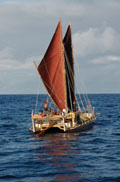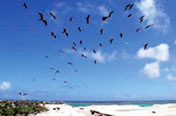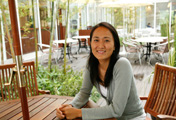Kanako Uchino, Ocean Photographer and Writer
Everybody knows, in their heart, that they are deeply connected to nature.
Encounter with the sea while at SFC




─ Why did you enter the Faculty of Environment and Information Studies?
Back then, SFC was in its 6th year. The concept of SFC, which is to study the world from diversified standpoints rather than from one specific field, seemed really new and appealing. Since I was little, I loved to get out into nature, and I eventually became interested in the natural ecology that stands in an exquisite balance. I joined a seminar class to study the relationship between environment and development, and learned how human activities have affected nature.
─ Tell us about your encounter with the sea.
I have always loved the sea, but the experience that led to what I am today was visiting Miyake island with a friend who also loved the sea. I explored the underwater world much deeper than my height for the first time, and was really fascinated by the world beneath the surface of the sea. The sea is close to us but is a completely different world. It is wildness right next to us. Since this visit to Miyake island, I really got into the sea, and would visit Izu peninsula every weekend for diving. The sea changes its appearance from season to season, so my youthfulness and curiosity would make me go diving even in midwinter. As much as I enjoyed the beauty and wonder of the sea, I also encountered many negative changes in the sea caused by human activities. I wondered what I could do to sustain this great environment for the generations to come. I wanted to become a “bridge between humans and nature”, to raise awareness how deep humans and nature are connected. I decided to pursue my study of ocean environment at the Graduate Division of the University of Hawai'i. I studied the ecosystem of coral reefs, as I wanted to know what was actually going on in the ocean. I also studied photography as my sub-major as a tool to share what I learned about nature to as many people as possible.
Encounter with Hokule'a
─ Why did you choose Hawaii?
That was because I got to know about Hokule'a, a traditional voyaging canoe of Hawaii. During my university days, one of my friends who knew how much I was into the sea introduced me to one book. That was my first encounter with Hokule'a. I hadn't thought about studying in Hawaii because I had the impression that Hawaii was a shopping paradise full of tourists, but after I read the book, my concept of Hawai'i changed 180 degrees. I learned that in Hawaii, there are many people who have profound knowledge of the sea, and that there is a traditional navigation technique that uses the sun, stars and wind instead of any modern instrument. Hokule'a is the canoe which has traveled millions of kilometers over the last 30 years using this traditional method.... every single thing was so surprising, and Hawai'i became the place I'm most interested in. However, back then, I didn't even imagine that I would become a crew of Hokule'a, let alone sailing with it back to Japan.
─ Then, what made you join the sea voyage?
After arriving Hawaii, I went to see Hokule'a. She had just finished a long voyage and was out of the water, and I participated in repairing the canoe for the next voyage. This was pure volunteer work that took a year, and people there are really committed to Hokule'a. As I spent time with these people, I could learn so much about traditional navigation as well as other Hawaiian culture. I then began to have opportunity for several short sea voyages, and in 2004, I was chosen as a crew for my first long voyage from Kauai to Midway. It was very special to spend days after days on the ocean. As I was rocked by the boundless ocean where all I can see is the horizon, I noticed that my senses became sharper and shaper.
Hokule'a travels to Japan
─ In 2007, Hokule'a set out on a long voyage to Micronesia and to Okinawa. Why did it head for Japan?
Until then, Hokule'a voyages were mainly within Hawaii, or in Polynesia, because the original purpose of the voyages was to prove that ancient Polynesians could travel through the Pacific without using any modern instrument. Hokule'a succeeded in voyages in last 30 years and fulfilled that purpose. Then they decided to expand their voyage beyond their cultural region, and the first place they though of was Japan, which has deep and long ties with Hawaii. The theme of this voyage was “One Ocean, One People”, which means that one ocean embraces cultural differences and connects everyone. We strongly hoped to bring the spirit of Hawaii closer to Japanese people through introducing the stories of Hokule'a.
─ Didn't you have anxiety or fear about going out to the vast sea without a chart or compass, only counting on nature?
We sure did, especially because this voyage was going to be as long as 5 months, the most risky voyage in the history of Hokule'a. Even those who have full knowledge of the sea could face great anxiety. Then, how do we overcome this? The only way is not to escape from it but to embrace it. The captain asked the crew many times, “Why are we going on this voyage? Why have you decided to go on Hokule'a?”. We all think hard about these questions, and eventually find answers. When you find your answer from your heart, that wraps up your anxiety, and you are able to live with your anxiety in a peaceful state of mind.
─ And what was your answer?
It was very clear to me that this voyage was not just for my own experience. It is about connecting people of Hawai'i and Japan through sharing cultures and values, as well as the gifts from the ocean. I believe that Hokule'a can pose questions to people like: What can we learn from the wisdom and tradition from our ancestors. How do we apply them to our life? What do we value, and where do we want to go as people? Hokule'a has the power to touch people's heart and makes them really think what matters the most. That is why we wanted to deliver Hokule'a to Japan. It was really important for us to have faith in what we do. Before arriving in Okinawa, we were caught in a big storm, but nobody got panic and we could overcome the crisis calmly. I think that was because we all had a clear sense of why we were doing this, and had faith in ourselves and in nature.
─ What did you feel when arriving in Japan?
Japan is a country consisted of more than 6,ooo islands, some small and some large. The beauty of these islands from the sea exceeded my expectations, and I could really see Japan as an island nation connected by the sea. After leaving Okinawa, we stopped by cities such as Nagasaki, Hiroshima and Yokohama. As we introduced the traditional navigation technique from Hawai'i, many people realized that Japan also has a long lasting tradition of living harmony with nature. People began paying more attention to their local wisdom and tradition, which were tended to be taken for granted, or even about to disappear. I believe Hokule'a taught many of us how precious and sacred our land and culture are.
We are “kept alive”
─ During the voyage to Japan, how was life on the boat?
The crews were mainly local people from Hawaii. 11 people of various ages ranging from the 20s to the 60s gathered, of which 4 were women. There was one captain and one navigator. The other 9 people were divided into 3 groups, and we worked twice a day for 4 hours each, a total of 8 hours, following orders of the navigator to steer the canoe. I was in charge from 10 to 14 o’clock and from 22 to 2 o’clock. I slept in the evening and before dawn for 2 hours each. I had only 4 hours of sleep every day, but interestingly, in the ocean, this wasn’t tough at all. More surprisingly, the navigator doesn’t sleep at all. He has to keep recording in his brain “how much we sailed in which direction”. If he sleeps, he will not be able to update the information. The navigator takes a 10-15 minute nap from time to time, but not a long sleep. You may feel that people on the canoe developed some special skills, but that is not necessarily true. When you are on a small canoe in the boundless ocean, you become more aligned to the nature and all your sense start getting very keen. The sun, the stars, the wind and the sky… the nature surrounding us are sending so many messages all the time. In the middle of the ocean, you realize that your abilities to understand these messages get better and better. For example, during the night, we learn which way to go by seeing the position of the stars at the horizon, and to do that, we have to memorize about 220 stars. You may think, “that is so hard”, but we humans have the ability to memorize that much and make use of it. In Micronesia, where the art of traditional navigation is still alive, everyone lives in harmony with nature. When people say that “it will start raining in 3 hours”, it really happens. They have developed a deep relationship with nature, and they live as a part of nature. “Nature and humans are deeply connected.” I believe everybody know this simple fact in their heart. My role is to let people remember that, and that is why I write, take photographs and share stories of the Hokule'a.
─ Finally, tell us about your outlook for the future, and give us a message for Keio students.
To share my experience and what I learned through the voyage to Japan to as many people as possible, I published a book called “Hokule'a; the path guided by stars” (Shogakukan). In addition, Hokule'a is planning to go around the world as her next sail. During the voyage, I felt strongly that “we are being kept alive by nature”. In the middle of the ocean, it become really clear how our life is supported by natural elements, and how precious they are. In Hawaii, there is a saying “a canoe is an island, and an island is a canoe”. We are truly living on a limited supply of water, food or any kind of resources, whether on a canoe or an island. We are “kept alive” by nature, and that is a wonderful fact. 10 years have passed since my graduation from Keio University. Doing my best on what I value always opened up the door to the next, and my life expanded to a world I didn’t even imagine when I was a student. I hope you respect what you feel passionate about, put all your energy to it and enjoy the process. That will open a way to your future.
Ms. Kanako Uchino graduated from the Faculty of Environment and Information Studies in 1999. During her university days, she became captivated by the sea, and after graduating from Keio University, she pursued her study at the Graduate Division of the University of Hawai'i in 2000. She studied the ecosystem of coral reefs, as well as photography as her sub-major. After finishing graduate school, she works as an ocean photographer and writer to introduce stories from nature, mainly of the sea. She also has been learning the traditional navigation technique of voyaging canoes used in ancient Hawaii, and became the first Japanese crew member of Hokule'a. In the summer of 2007, she went on board Hokule'a from Micronesia to Japan. She put together her experience of this voyage into a book “Hokule'a; the path guided by stars” (Shogakukan) which was published in June.
